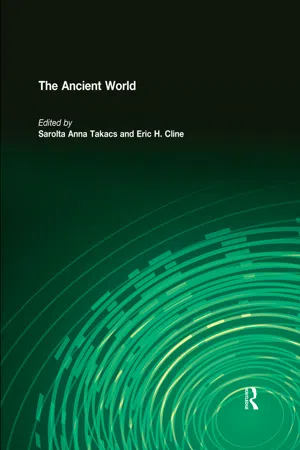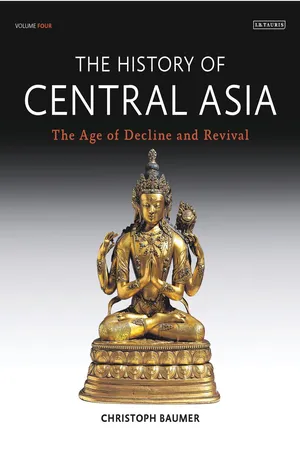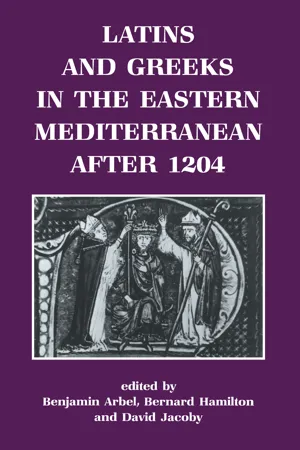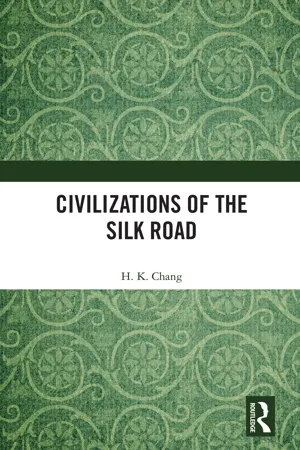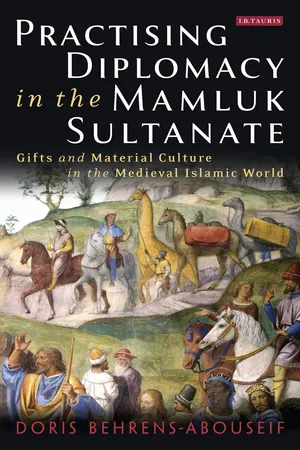History
The Golden Horde
The Golden Horde was a Mongol khanate that ruled over parts of Eastern Europe, Central Asia, and the Caucasus in the 13th and 14th centuries. It was established by Batu Khan, a grandson of Genghis Khan, and became known for its significant impact on the region's political, economic, and cultural development. The Golden Horde played a key role in shaping the history of Eurasia during this period.
Written by Perlego with AI-assistance
Related key terms
Related key terms
1 of 4
Related key terms
1 of 3
9 Key excerpts on "The Golden Horde"
- eBook - ePub
- Sarolta Anna Takacs, Eric H. Cline(Authors)
- 2015(Publication Date)
- Routledge(Publisher)
G—KGenghis Khan
See China ; Mongols .Golden Horde
Western regions of the Mongol imperial confederacy that once connected the Middle East to China, established by the conquests of the Mongolian conqueror Genghis Khan (r. C.E. 1206-1227). The Golden Horde, which consisted of the Caspian steppes, the Crimea, the northern Caucasus, and the Ural basin in what became western Russia, was home to a collection of seminomadic tribesmen, farmers, and townspeople. This confederacy was financed by collecting taxes from farmers and townspeople along the Silk Road across central Asia, which since the first century B.C.E. had served as the overland trade connection between Europe and eastern Asia.In contrast to the Mongols, who eventually assimilated into the urban Chinese and Persian civilizations they conquered, the Turkish tribesmen who founded the Horde retained their seminomadic culture. Mongol chieftains (khans ) ruled the Horde indirectly, employing subservient native princes to carry out their orders. Mongol residents (baskaks ) and, later, nonresident representatives (posoly ) supervised the activities of the khans.The Golden Horde reached the height of its power under Allah Khan Ozbeg (r. 1313-1341). During his reign, the Mongol khans, baskaks, and posoly converted to the Islamic religion, in part to strengthen their ties with their powerful Islamic Mamluk Egypt-based neighbors to the southwest. However, they remained tolerant of their Roman and Orthodox Christian residents rather than forcing them to convert as well.Despite regular succession crises and the late fourteenth-century victories of Samarkand-based Tamerlane (d. 1405), a Turkik-Mongol who claimed authority as the rightful descendent of Genghis Khan, the Horde remained in power until the reign of Akhmar Khan (r. 1465-1481). In 1471-1472, Prince Ivan III of Muscovy defeated Akhmar's troops, and Akhmar himself failed to recapture Moscow in 1480. The last remnants of the Mongol realm collapsed in 1502, when Ivan allied with the Crimean khan Mengli Girei to crush the Horde's remaining centers of power. - eBook - ePub
The Indian Frontier
Horse and Warband in the Making of Empires
- Jos Gommans(Author)
- 2017(Publication Date)
- Routledge(Publisher)
Hence, this region was part of the early Mongol conquests which destroyed Kiev, the city which for centuries had been the main cultural and political centre of Russia. Devastated by the nomadic invasion, it actually became the new heartland of one the four Chinggisid successor empires, the so-called ulus of The Golden Horde, or Qipchaq Khanate. Although profiting from its commercial links with the Black and Mediterranean Seas, the area appears to have experienced a catastrophic decline as a result of both epidemics and the destruction of its economic bases at Azov, Astrakhan and Urgench under Timur’s campaigns in the 1390s. 101 From the second quarter of the fifteenth century The Golden Horde fragmented into various successor states which created a new balance of power among five political entities, each of medium economic and political might: (1) Muscovy itself; (2) the Crimean Khanate, nominally under the Ottomans after 1745; (3) the Great Horde, replaced by the Astrakhan Khanate in 1502; (4) the Kazan Khanate; and, finally, (5) the Tiumen’ Khanate or Sibir. In fact, the four Tatar Khanates should not be considered fully nomadic states but instead, like so many polities in the Middle Zone that have been discussed so far, as a mixture of nomadic and agricultural communities under the leadership of so-called ‘begs’. The term Tatar itself did not necessarily refer to nomads but denoted almost all non-Christian inhabitants, mostly with a Turkish background and of Muslim faith. In any case, at the interstices of these enclaves of political centralization and mixed economies, there were truly pastoral groups such as the Nogais, Bashkirs, Kalmyks and Kazakhs. Moscovy’s military successes against Kazan and Astrakhan was in no small degree based on its alliance with these groups, and in particular the Nogais, who delivered crucial transport services and, above all, a large number of excellent warhorses - eBook - ePub
- Christoph Baumer(Author)
- 2018(Publication Date)
- I.B. Tauris(Publisher)
10216. The Kul-Sharif Mosque, completed in 2005, inside the Kazan Kremlin in Tatarstan, Russia. Photo: 2013.4. The Descendants of The Golden HordeBetween 1240 and 1550, the area between the Volga and Ural rivers belonged politically, ethnically and linguistically to Central Asia or at least to its north-western sphere of influence. Ultimately, the rulers of The Golden Horde who, at its peak, dominated the region from the lower Danube to the middle reaches of the Ob were Mongols and Kipchaks. But The Golden Horde had already begun to dwindle on its western border in the first half of the fourteenth century under pressure from the Grand Duchy of Lithuania and from Hungary. Internal power struggles and the outbreak of the ‘black death’ weakened the horde further. After the campaigns of Timur-e Lang in the 1390s, when he deliberately destroyed the commercial cities and transport hubs of the horde, its demise accelerated, giving way to a process of fragmentation.103 Parallel to this decline, the Grand Duchies of Lithuania and Moscow became stronger. Yet while the Lithuanian-Polish Kingdom had to deal with the neighbouring rivals Moscow, Crimea and several German military orders, Moscow turned to the south-east – to the Volga and the Caspian Sea, and, to the east, to Siberia. Towards the end of the sixteenth century, the political border between Europe and Central Asia had already moved from the Volga to the Urals. In this time of upheaval, the Tatar khanates of Kazan, Kursk, Crimea, Astrakhan, Kasimov, Sibir, the Nogai Horde and the Great Horde emerged.1044.1 The Khanate of Kazan and the Small Khanates of Kursk and KasimovWhen the Jochid Khan Ulugh Mohammad of The Golden Horde (r. 1419–21, 1428–33, in Kazan in 1437/38–45) was expelled from Sarai for the second time in 1433, he first fled to Crimea. He then conquered the city of Kazan in the winter of 1437/38 and founded the khanate of the same name105 (figs. 16 , 20 ). The conquest was successful despite the military resistance of the Moscow Grand Duke Vasily II, who wanted to prevent him from taking over this strategically important trading city. In the same year, 1438, the small Tatar Khanate of Kursk, also called Jagoldai, similarly emerged south-west of Moscow. It soon subordinated itself to the Grand Duchy of Lithuania and was conquered by Moscow in 1508.106 Kazan replaced Bolghar, which lay 90 km further south on the Volga. Both cities controlled trade on the Volga, which connected Moscow with the Caspian Sea via the Moskva and Oka rivers. Bolghar’s decline had already begun in the second half of the fourteenth century, and the city was further depopulated after the Russian invasion of 1432. Numismatic finds dating from 1408 show that Kazan overtook Bolghar as the new commercial and administrative centre no later than the beginning of the fifteenth century. At that time, the city was called New Bolghar.107 The khanate of Kazan bordered on Moscow to the west; on Sibir to the east; on the Nogai Horde and its Bashkir vassals to the south-east; on The Golden Horde, and from about 1466 the Great Horde, to the south-west; and, finally, to the south, on the steppe between Astrakhan and Don, an area of dispute for the Nogai and Crimean Tatars. The Muslim khanate was ruled by a khan from the house of Genghis Khan, but his power had been severely limited by the Tatar nobility.108 Unlike The Golden Horde, the khanate was not a steppe empire, but it had an urban-mercantile capital and its population included farmers and woodland hunters. Kazan’s culture was also a hybrid, because the steppe culture of The Golden Horde in the khanate had been enriched with Volga Bulgarian109 elements. In ethnic terms, the rather small khanate was likewise varied, consisting of urban Turkic-speaking Kazan Tatars and, in the countryside, of Turkic-speaking Chuvash, Finno-Ugric-speaking Mordvins and Cheremis, and of Udmurts (Votyaks), whose Udmurt language belongs to the Permian group of the Finno-Ugric language family.110 - eBook - ePub
- Shogo Suzuki, Yongjin Zhang, Joel Quirk, Shogo Suzuki, Yongjin Zhang, Joel Quirk(Authors)
- 2013(Publication Date)
- Routledge(Publisher)
The second part of the chapter focuses on how Russian cities experienced being part of a Mongol polity, and the third part on how the consequent hybridization fed into Russia's entry into international society. The theme of this chapter, then, is the experience by a specific sub-set of Christians (we cannot in good faith call them Europeans, because this was a concept that was in use briefly during Charlemagne's reign and did not pop up again until the first half of the fifteenth century) of being dominated by ‘non-Europeans’, and how this experience was, in the period of key interest to this volume (1492–1792), somehow seen as contaminating by other Europeans.Note that, as seen from the Khipchak Khanate, the key point of interest was not Russia or Europe, but first the Mongol imperial centre at Karakorum, and when the centre lost its hold towards the end of the thirteenth century, another of the Mongol empire's successor states, namely the Il-khan empire to their south-east, with which it quarrelled continuously about tribute taking in and trade routes through the Caucasus (of which more below). Mongols were past masters of many things, one of them being to provincialize the Russian lands. Western historiography has, nonetheless, insisted on treating what happened in these parts, at this time, from a Slav, sedentary point of view only. We may see this already in the name given to the polity, which is ‘The Golden Horde’. That was how Russian speakers, a subaltern part of the polity, referred to it. The narratives about ‘The Golden Horde’ are predicated on ‘the notion that the West properly deserves to occupy the centre stage of progressive world history, both past and present’ (Hobson 2004: 2). The concept for such a stance is Eurocentrism. The point has often been made that Russian historiography has tried to bury the length and intensity of Mongol control over Russian lands. European historiography has been little different.The Mongols
The size of the Mongol population at the time of Chinggis Khan has been estimated at 700,000 (Allsen 1987: 5). Although the Mongol made eminent use of heavy wooden saddles and composite bows, their key advantage in warfare was their strategy. The Mongols emphasized protracted training, advance planning, multi-strand coordination and tight discipline. Alone at the time, they concentrated their thinking not on the single combatant or on a small group of soldiers, but on the tümen (Russian: t'ma ), a unit ideally composed of ten thousand men. It was officially recognized that actual turnen would be undermanned, for an ‘upper tümen ’ was stipulated as having a minimum of 7,000 troops, a middle 5,000, and a lower only 3,000 (Allsen 1987: 193). The land needed to man a tümen - Benjamin Arbel, Bernard Hamilton, David Jacoby(Authors)
- 2012(Publication Date)
- Routledge(Publisher)
19 he was indeed distracted by an attack on his eastern frontier. Similarly the rulers of The Golden Horde were not in a position to devote their attention exclusively to the expansion of their territory in eastern Europe or the Balkans for fear of trouble on their Caucasian frontier. Even had this not been so, there could be no further attempts to expand the Mongol empire as a whole, with military contingents contributed by all parts of the empire, as had been the norm until the 1250s. Military operations were now the concern of the individual Mongol khanates, which inevitably did not dispose of resources on the scale which had been possible for the united empire.The situation, from the Mongol point of view, was indeed even worse than this. Not only were different branches of the Chinggisid family at daggers drawn: in the case of The Golden Horde, it was now thought reasonable for a Mongol khanate to involve itself in a permanent alliance with a non-Mongol power, the Mamluk regime, against fellow Mongols. The principal credit for this turning upside down of Near Eastern politics must belong to Baybars, who had lost little time in making the most of his opportunity. But the part played by the restored Byzantine empire was, as we have seen, not negligible. And Michael VIII’s agreement with the Genoese in 1261, just before the recapture of Constantinople, made it possible for them to establish themselves in Golden Horde territory, at Kaffa in the Crimea, from where they were able to contribute to the maintenance of The Golden Horde–Mamluk slave trade. The Byzantine emperors had to tread very carefully between the Mongols of Russia and those of Persia; and on the whole they achieved a remarkable degree of success. There were no invasions of the Asian territories subject to Byzantium on the part of the affronted Īlkhā ns.None the less, the period of Ilkhanid supremacy in Anatolia saw a severe erosion of the Byzantine lands on the Asian side of the straits. No doubt this was partly the result of the comparative neglect suffered by the former lands of the empire of Nicaea by the government in Constantinople, once the capital had been recovered. But something needs also to be said about the nature of Ilkhanid rule in Rū m. During Hülegü’s time and most of the reign of Abaqa, the Seljuk sultanate was in the firm hands of the celebrated minister Mu‘ī n al-Dī n Sulaymā n the Parvā na, who, like his father before him, exercised on behalf of the Mongol overlords far more effective power in the sultanate than did the sultans themselves, who were generally little more than ciphers. The rule of the Parvā na came to an end when Baybars invaded Anatolia in 1277, inflicting a severe defeat on the Mongols at Albistā n.20 While the invasion did not lead, as Baybars seems to have expected, to a Turkish rising against the Mongols, it did bring severe reprisals at the hands of the Īlkhā n Abaqa. The Parvā na was blamed for the defeat at Albistā- Peter Jackson(Author)
- 2023(Publication Date)
- Routledge(Publisher)
ghdād and murdered the Caliph (1258), and rolled onwards through ‘Irāq into Syria. For a time it appeared that the entire Islamic world would succumb to this threat; then events further east supervened.1 On the attempt by Ögedei’s family to recover power, and on their fate, see Sir H. H. Howorth, History of the Mongols, London 1876-1927 (3 vols in 4 & suppt), I, pp. 170-3; R. Grousset, L’Empire Mongol (Ire phase), Paris 1941 (Cavaignac, Histoire du Monde, VIII/3), pp. 306-11; idem, L’Empire des Steppes, 4th ed. Paris 1965 [henceforward Steppes ], pp. 338-41; V. V. Bartol’d, Turkestan down to the Mongol Invasion, trans. H. A. R. Gibb, 3rd. ed. C. E. Bosworth, London 1968 (Gibb Memorial Series, n. s., V), pp. 478-80.2 For Rubruck’s testimony, see especially Turkestan 1968, p. 480, & Bartol’d, Four Studies on the History of Central Asia, trans. V. Minorsky, Leyden 1956-62 (4 vols in 3), I, p. 121.Within a space of three years, the Mongol empire was torn apart by two major wars between members of the imperial family. Möngke’s death while besieging a fortress in China in 1259 unleashed a struggle for the succession on the part of Qubilai and Tolui’s fourth son, Arigh–böke, of whom the former was victorious only after a five years’ war which spread from Mongolia into Central Asia.3 At the same time the new Mongol power in Iran clashed with its neighbours beyond the Caucasus, The Golden Horde, now ruled by Batu’s brother, the Muslim convert Berke (1261). The rivalry of these two westernmost divisions of the empire was to last, with intervals, for almost a century. Its effect on the Mongol advance in the Near East, which had already been checked by the Mamlūk rulers of Egypt in two engagements, at ‘Ain Jālūt and at Ḥimṣ, in 1260, was profound. Hülegü had withdrawn eastwards with the bulk of his army in order, presumably, to keep watch on the succession dispute in Mongolia, and these reverses were inflicted on the greatly depleted Mongol forces left in Syria and Palestine. In view of the threat from The Golden Horde, neither he nor the later monarchs of the dynasty he founded in Iran (the ‘Ilkh- eBook - ePub
- H. K. Chang(Author)
- 2023(Publication Date)
- Routledge(Publisher)
Kuriltai, but when he reached Saray on the west bank of lower Volga, he was saddened to hear that Gükyü, Ögedei’s son, had already been designated Great Khan. So Batu elected to remain in the west, where he founded the Kipchak Khanate (Golden Horde) with Saray as its capital and governed the western steppes of Asia, Volga Valley, the Caucasus, and a large part of Eastern Europe, including Moscow and Kiev.The third expedition was led by Hulagu, son of Genghis Khan’s fourth son, Tolui. His army first pacified the various strongholds of the Ismaili “Assassins” in Persia before he destroyed the Arab’s Abbasid Dynasty, executed the caliph, and battled all the way to Damascus. But just as he lay siege to the city, he learned that the Great Khan had passed. Determined to take part in the Kuriltai that would anoint the Mongol’s new “Great Khan,” he led the lion’s share of his forces back eastward, leaving behind only a small number of troops in the hands of a loyal general. In the end, this general was outnumbered and defeated by the Egyptian Mamluk army—the biggest setback of the three Mongol expeditions. The Mongol army was demoralized and the expeditions were halted.Overall, from 1219 when Genghis Khan attacked Khwarazm until 1259 when Möngke died in battle while fighting the Southern Song forces and Hulagu abandoned his planned siege of Damascus to return eastward to the Mongol homeland, the Mongols brought great turmoil to the Eurasian continent.Aside from the fierce fighting spirit of this nomadic people, the army’s invincibility was also due to several unique factors. The speed of the Mongols on the ground was so astonishing that it often caught its opponents by surprise. Prior to the advent of the motorized vehicle, according to military scientists, no army ever moved with such rapidity. Firstly, it was due to their fine horses; secondly, the obedience of the warriors; and lastly, their unique techniques of waging war. - eBook - ePub
- F. W. Mote(Author)
- 2003(Publication Date)
- Harvard University Press(Publisher)
Batu was originally granted four chiliarchies of Mongol cavalry and their dependents, perhaps 25,000 persons in all, and he settled down to rule over his khanate from the first of two Golden Horde capitals, Old and New Sarai, built successively on the lower Volga. The critical mass of Mongols in his realm was inadequate to long preserve a Mongol identity; his khanate came to be known as the Kipchak Horde as its Turkic population gradually absorbed its Mongols, turning it into a Turkic-speaking realm. When Batu died in 1256, his brother Berke succeeded him as khan and led his people in a conversion to Islam in the 1270s, thereby erasing a major distinction between Mongols and the Turkic nomads of the region. That was the first bloc of Mongols to adopt the religion that eventually would claim all the Mongols outside of Mongolia. Batu’s successors maintained their indirect rule over the Russians (the “Tatar Yoke,” as The Golden Horde’s power to coerce and collect taxes was called) until late in the fifteenth century. Berke, heading The Golden Horde when Möngke died in 1259, did not accept Khubilai’s irregular succession and seemed on the point of throwing his support to Arigh Böke, the youngest brother of Möngke, who also claimed to have been validated by a sparsely attended khuriltai held in western Mongolia in 1260, and who then declared war on Khubilai. Arigh Böke was much more the model Mongol warrior chieftain than was Khubilai, and for that reason probably had considerable support throughout the Chinggisid lineages and among the tribal nobility. A civil war lasting four years ensued before Khubilai prevailed. The threats to the stability of Mongolia gave the alliance between the other two brothers, Khubilai and Hülegu, great strategic importance. Hülegu died in Persia in 1265; his son and heir Abakha ruled ably until his death in 1282 - eBook - ePub
Practising Diplomacy in the Mamluk Sultanate
Gifts and Material Culture in the Medieval Islamic World
- Doris Behrens-Abouseif(Author)
- 2014(Publication Date)
- I.B. Tauris(Publisher)
HAPTER 5THE BLACK SEA, ANATOLIA, IRAN AND CENTRAL ASIAThe Golden Horde at the Black SeaAfter having conquered Central Asia and Iran, the Mongols led by Hulagu took Baghdad in 1258, terminating the Abbasid Caliphate, and aiming further at Syria and Anatolia. Their advance in Syria, however, was brought to a halt two years later at the Battle of ‘Ayn Jalut, where for the first time they had to accept a defeat by a Muslim army, led by the Mamluk sultan of Egypt, Qutuz, and his general, al-Zahir Baybars. Qutuz was not intimidated by the aggressive message sent by Hulagu demanding his submission; rather he executed the envoy and ordered that his head be displayed at the southern gate of Cairo, Bab Zuwayla. The triumph at ‘Ayn Jalut showed the Mamluks to be the only power capable of challenging the Mongols so far. However, the Battle of ‘Ayn Jalut did not bring about the end to hostilities between the two powers. The ghost of Jenghiz Khan continued to haunt the Mamluk Sultanate through his successors, the Ilkhanid dynasty of Iran, who after converting to Islam and adopting Iranian culture as their identity, continued to challenge Mamluk supremacy both on territorial and religious grounds.The Mamluks were not alone in standing up to the Ilkhanids. They found an ally in The Golden Horde, a tribe of the house of Jenghiz Khan that had settled in the Kipchak steppe north of the Black Sea. Berke Khan, who was their first ruler to convert to Islam, challenged the scheme of Ilkhanid hegemony in the Muslim world. An alliance between Berke and Baybars was celebrated by a special Mamluk gift package sent with an embassy to The Golden Horde in 1263.1
Index pages curate the most relevant extracts from our library of academic textbooks. They’ve been created using an in-house natural language model (NLM), each adding context and meaning to key research topics.
Explore more topic indexes
Explore more topic indexes
1 of 6
Explore more topic indexes
1 of 4
